
Wrangell St Elias Hiking:
From A Hiker Who Has Been There
By Diane Spicer
Wrangell St Elias hiking will blow your mind.
It can also blow your time and money budgets.
- It takes determination and cash to access the plethora of hiking choices, requiring many hours on dusty gravel roads, expensive food and lodging, and sometimes bush planes - before you even get your hiking boots dirty.
So in an effort to avoid misunderstandings, let's distinguish between the levels of time and effort you need to invest in planning your Wrangell St Elias hiking:
- day hikes
- front country hiking
- and back country adventures
in Wrangell St Elias National Park and Preserve.
But first, some context about Wrangell St Elias hiking
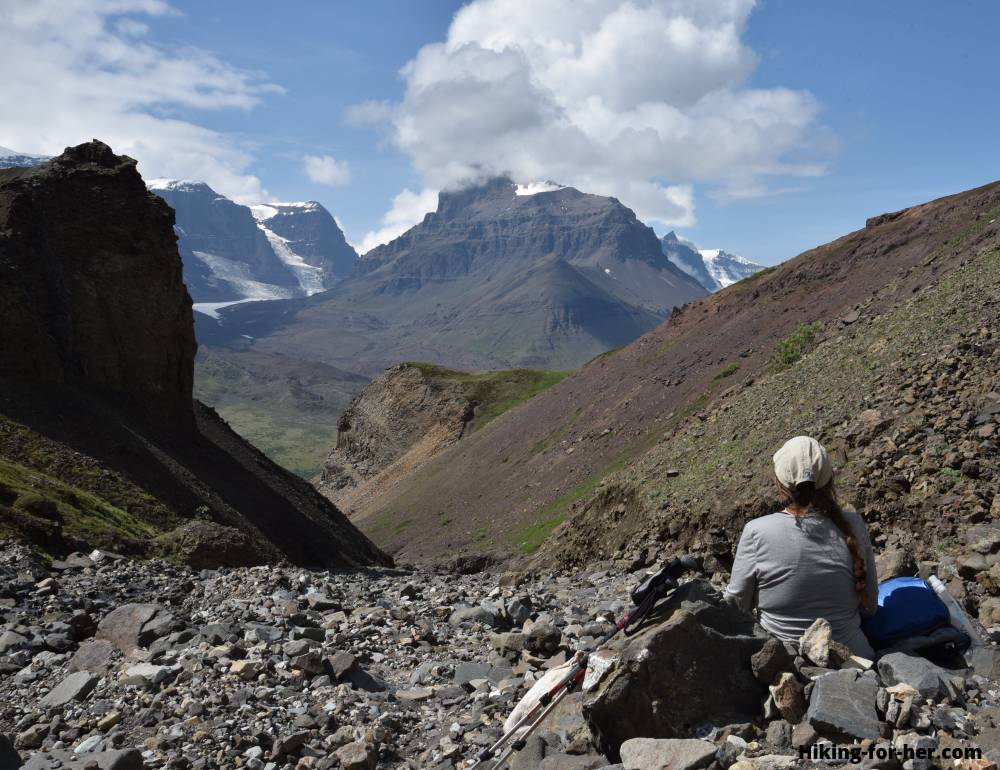 Sit and gawk at these spectacular mountains. There's no rush in the endless Alaskan summer daylight.
Sit and gawk at these spectacular mountains. There's no rush in the endless Alaskan summer daylight.Wrangell St Elias National Park and Preserve in southeast Alaska is huge.
- Huge enough that you will need many summer seasons to explore it as a hiker.
- Or decide right now to accept your fate as a mere mortal and plan to explore one tiny corner of the park in two weeks, as I did.
You can always go back for more!
The idea of 10 MILLION acres set aside for outdoor recreation definitely should get you excited.
To put this in context:
While the Grand Canyon receives 4 million visitors a year, this vast national park is visited by less than 70,000 people annually and most of them in the summer time.
And I'm willing to bet that many of those folks are not hikers.
- They prefer flightseeing tours from bush planes.
- Or taking in the historical aspects of the park, as in touring Kennecott mine ruins.
- Or salmon fishing, or... so much to do besides hiking!
So let's be clear:
The information on this page is targeted to you as a hiker wanting to get your boots dirty here without getting sucked into tourist activities.
- Those are optional after your hiking trip, right?
Where to start planning a hiking trip to Wrangell ?
The National Park Service (NPS) has many helpful suggestions about how to tap the never ending potential of Wrangell St Elias hiking.
These NPS links cover your biggest challenges: ground transportation, unpredictable and sometimes brutal weather, and big predators.
- Only two gravel roads enter the park: McCarthy and Nabesna
- Be bear aware and take precautions with food (black and brown bears)
Now let's look at how to plan three different hiking options for Wrangell St Elias.
Wrangell St Elias hiking:
day hikes
Let go of any expectations of well established, marked and easy trails for day hiking.
- Because those are as elusive as the mountain goats in this neck of the woods, and only the first few miles into an interesting area may be a recognizable trail.
Instead, think of hiking routes for longer day hikes and multi-day trips.
- Which means your map reading and GPS skills should be up to snuff.
To get started with some Wrangell St Elias day hiking, you need to get yourself to one of two places, either McCarthy (actually, nearby Kennecott) or the Nabesna Road area.
Full disclosure: There seems to be a bit of dispute about how to spell Kennicott (Kennecott), which is charming but maddening. You'll see what I mean if you skip around on the links I provide :)
- The McCarthy/Kennecott valley has a rich history related to miners wanting to get rich from copper. They left buildings, artifacts, and more in the valley as a reminder that when we don't pack out what we pack in, it can create problems for future visitors.
- I didn't visit the Nabesna area, so have no comment other than to note that the above Nabesna Road link will point out campgrounds and trails (rated moderate day hikes) along the Nabesna Road.
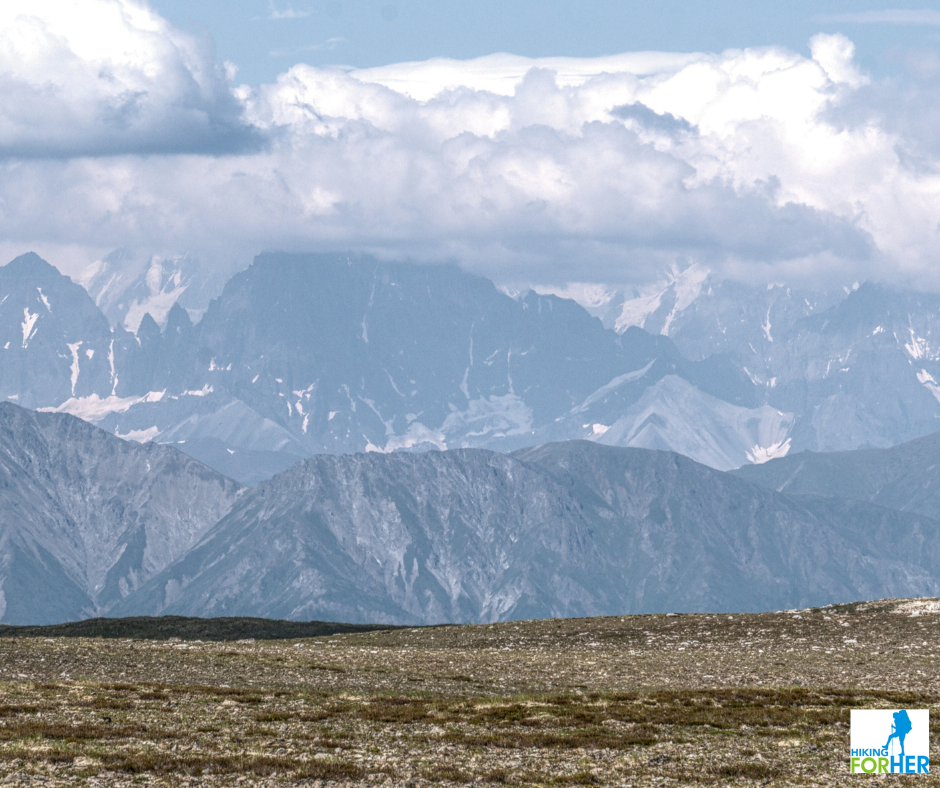
McCarthy day hiking opportunities
This link offers you free pdf downloads of the area hikes.
Some are rated easy, others as strenuous. Take that with a grain of salt.
But regardless of which day hike you pick, always remain aware that you are in bear territory.
- Bear spray should be with you.
- The NPS will rent you some if you'd rather not invest in your own.
Wrangell St Elias
front country hiking options
What does "front country" mean?
- You can access a trail head or the beginning of a route from a road, as opposed to flying in to access your hiking routes (i.e. back country).
Day hiking (see above) is one way to explore this marvelous park, using a cabin or campground for base camp each evening.
Another approach is to backpack on multiday trips through the front country.
- You save the cost of flying into a less visited area, using your own leg power instead.
- It's great for those with limited time.
- If you're new to backpacking, you can get your boots muddy with a small-ish adventure to build up your hiking resume.
Alaskan backpacking requires a skill set it might be hard to come by elsewhere, including glacier travel and swift water crossings.
- Use caution when planning your trip, looking at more than one source for route information.
- Be scrupulously honest about your skills and don't overestimate your enthusiasm for the ruggedness of the terrain and weather.
Here's an example of a 3 - 5 day backpacking adventure which leaves from the town of McCarthy:
- Donoho Lakes Glacier Trek, described in words and pictures here.
Wrangell St Elias hiking:
back country options
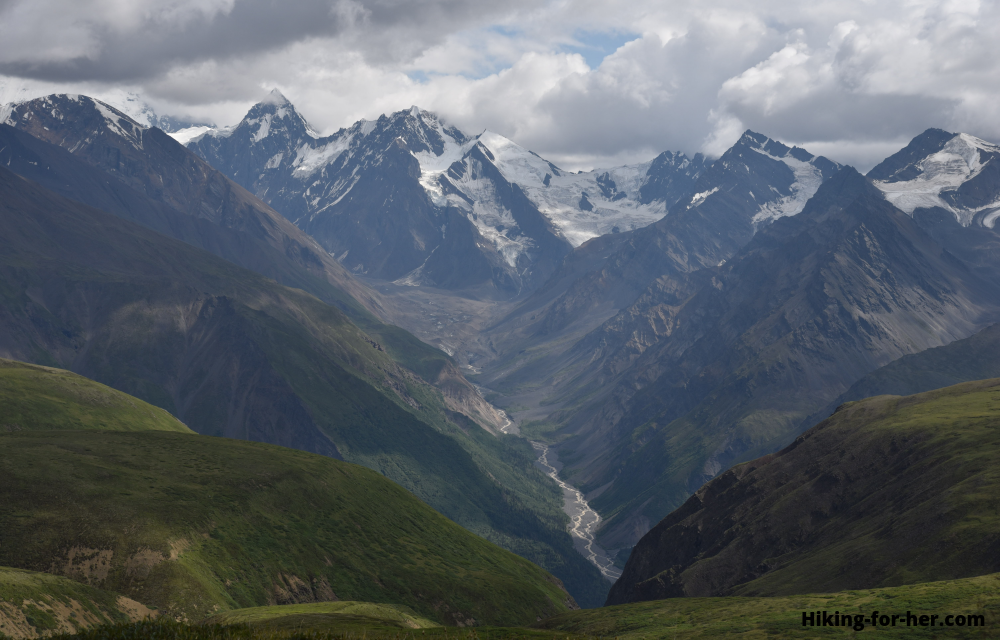 Deep river valleys surrounded by nameless mountains - a true backcountry experience for hikers
Deep river valleys surrounded by nameless mountains - a true backcountry experience for hikersThis is a wild, remote area you're planning to explore.
You need to be prepared for losing a lot of front country amenities:
- easy (or easier) navigation
- reliable communications
- access to roads and ground transport
- timely medical help
- easy food and fuel resupply options
Now that you have a clear idea of just how big of a bite you're chewing on, your options are seemingly endless.
Leaving out of McCarthy, you can put together a short backpacking trip that offers a lot of route finding and fantastic scenery, like the 2 - 4 day Doubtful Creek trip.
Or you can stay out for 8 days, navigating your way along the well named and popular Goat Trail which leaves from the Skolai airstrip.
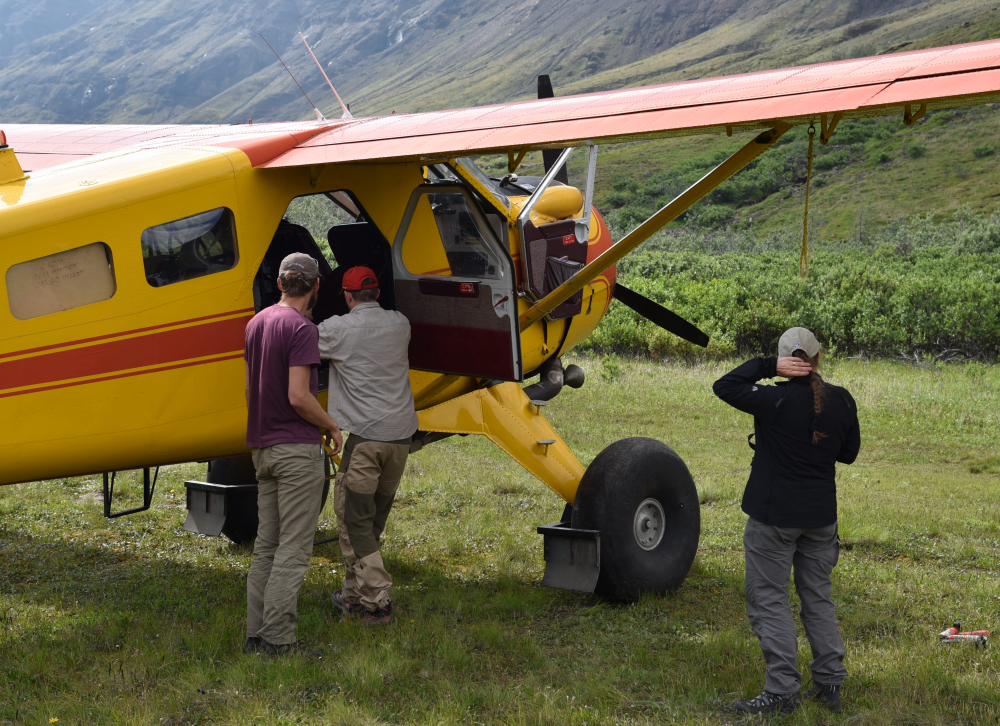
Heads up!!
Along with offering you spectacular sights under vast skies, the terrain will present you with many "interesting" hiking challenges:
- mud holes that suck off your boots,
- hummocky surfaces (irregular and tricky to negotiate),
- muskeg (boggy ground),
- biting insects,
- bushwacking through tenacious willows and other vegetation,
- boulder field navigation that will torment your ankles,
- dicey footing on steep, slick slopes,
- deep ravines with steep sides to climb out of,
- stream crossings of various depths and bottoms,
- bear scat and enormous prints to get your heart racing.
And that can be in the first day of hiking!
So be sure you are mentally and physically prepared for working hard for your views.
Nothing comes easy to a lowly hiker in this rugged corner of the world.
- But the rewards will be exponentially savored, compared with your investment of effort, when you are prepared and well equipped.
My backcountry experience
in Wrangell St Elias
You can read my Wrangell St Elias hiking trip report for one approach to back country hiking that worked well for a 12 day trip: bush plane supported base camping with serial day hikes.
McCarthy was chosen as the jumping off point for my hiking trip because of its embarrassment of wilderness riches: access to the largest collection of 14,000+ feet peaks and highest number of glaciers compared with anywhere else on the North American continent.
- My report includes details of driving from Anchorage to McCarthy, and flying out of McCarthy to three hiking destinations: Skolai Pass, Nizina Lake, and Wolverine, in that order.
- And here's my second Wrangell St Elias hiking trip report: Steamboat Hills, Bremner, and Fan Glacier.
- Wrangell St Elias gear list
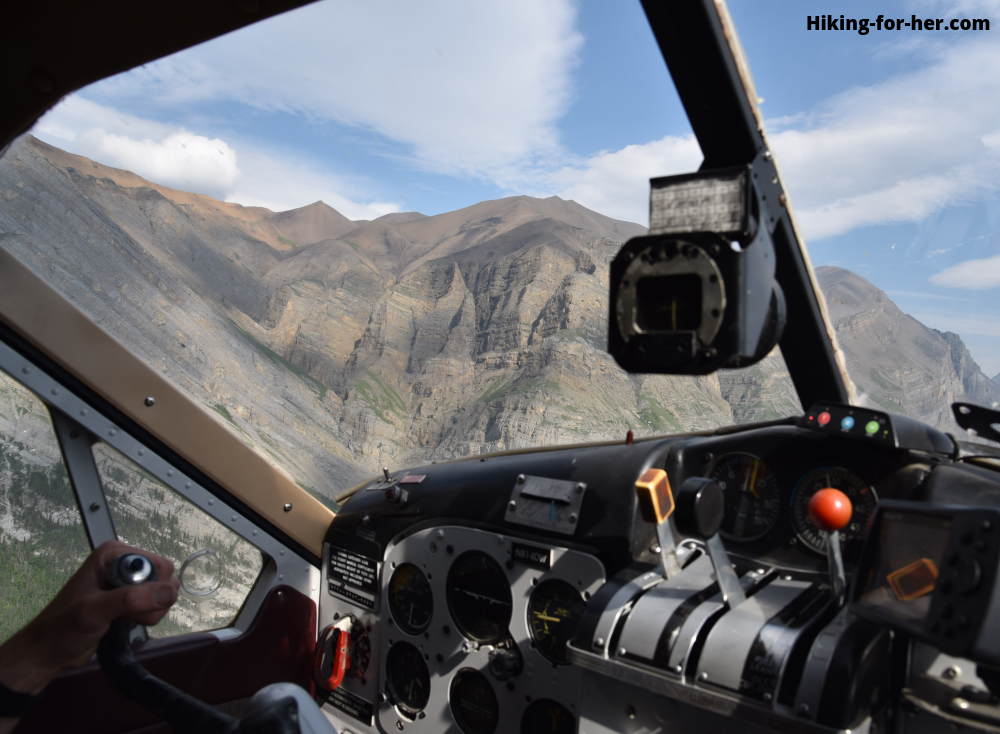 Too busy looking out the window to worry about what the pilot is doing at the controls of this bush plane!
Too busy looking out the window to worry about what the pilot is doing at the controls of this bush plane!
A few things to note about
backcountry travel
This rugged country can be intimidating: deep ravines filled with brush, loose scree to cross on the flank of a mountain, deceptively dry looking mud holes to suck you in, bear sign everywhere, and more.
Here are my top three things to know before you start poring over tempting topographical maps:
Hiring a backcountry hiking guide is a great way to get acquainted with Wrangell St Elias hiking without being stressed out by logistics or choosing destinations.
- Contact me if you'd like a recommendation.
Strict proper bear protocol is required, including keeping a clean camp and storing food in the proper containers. If this is a new habit for you, rest assured that bear canisters and Ursacks are easy to use but are not easy to acquire once you arrive in the park.
- Be sure to plan ahead for this NPS rule.
- You can put down a deposit on a bear canister and get a refund when you return it.
I recommend that you use trekking poles.
- The uneven terrain will challenge your sense of balance.
- Poles give you extra stability as you navigate steep grassy, sandy or rocky slopes, and the ability to probe ahead through mud holes and muskeg.
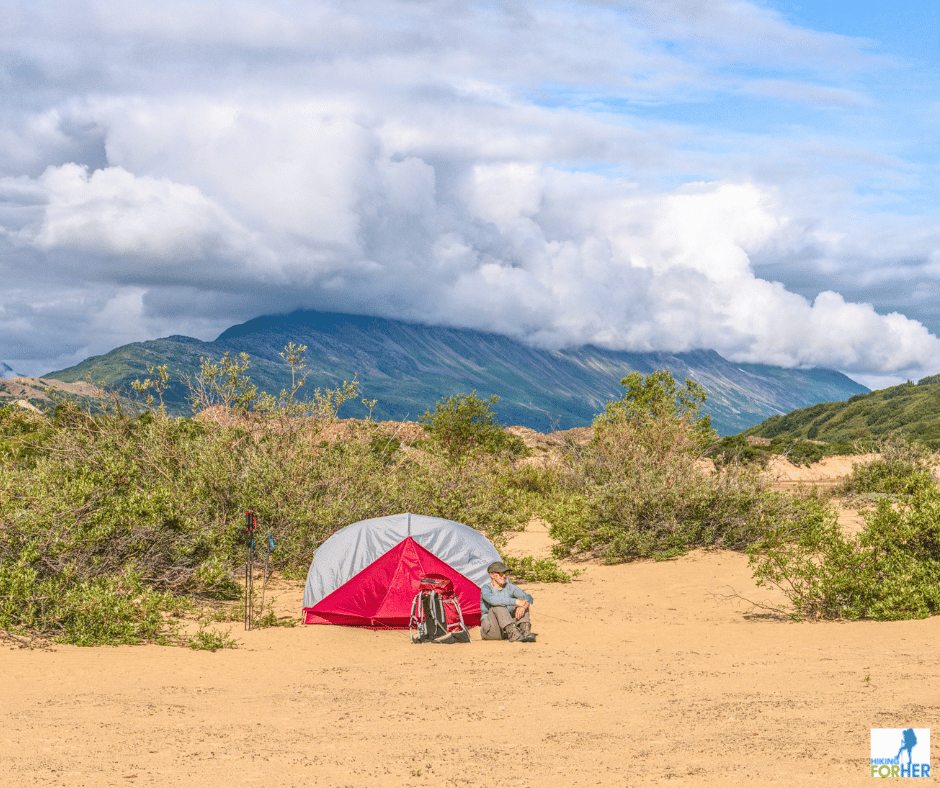 Lots of diversity in terrain in the Wrangells
Lots of diversity in terrain in the WrangellsQuestions for me about Wrangell St Elias hiking?
Not a lot of hikers opt to head into this national park each summer.
If you're looking for a place that answers to this description, make room on your hiking bucket list for Wrangell St. Elias:
- remote
- pristine
- vast
- mountainous (mostly unnamed peaks, many over 12,000 feet)
- roaring glacial melt rivers
- glaciated landscapes
If you'd like more information about what the hiking out of McCarthy was like, I'd be happy to chat.
- For a glimpse of glacier day hiking at Nizina Glacier, go here.
Contact me with your questions, I love to talk about my experiences with Wrangell St Elias hiking.
- Or read the definitive hiking guide to this park, and then contact me!
Wrangell St Elias Hiking
|
I get emails all the time about what I wear, eat, carry and love to use on the trail. That's
why I provide affiliate links to you: the best gear that I use myself and have seen used by other hikers is instantly
available for your consideration, and the gear company sends a few
pennies per dollar to this reader-supported hiking website. There is no added cost to you! Everyone ends up a winner: Great gear for you, strong gear companies, and more free hiking tips for everyone. Thanks very much for your support. It's warmly and sincerely appreciated. It also helps send these hiking tips to all your virtual trail buddies around the globe. |
 |

